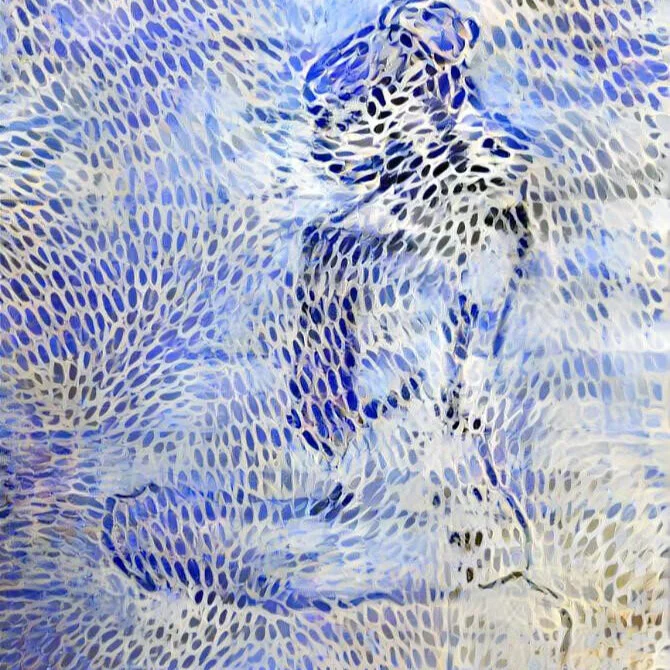Sarah Daly, a classically trained artist and innovation expert, describes the process behind the AI innovation inside her art practice, and opens up thinking on how more of us might start to use AI to innovate.
I had an innovation problem.
I have two themes in the art that I make.
One theme investigates the world we exist in: where we live and how we are connected through the land we all stand upon. I make abstract aerial landscapes using repetitive mark-making (lots of dots, nets, fine brush strokes). They represent places that either I am connected with, or are meaningful to the clients I’m painting for.
The second theme is figurative. Life drawing (in lay terms, drawing or painting a person who is in the room with you, rather than from a photo) is something I’ve been trained in since I was 15 and developed further at post-graduate level. By looking deeply and in detail at the human figure, getting a sense of the person we are drawing, artists can get insights about the human condition that can only be achieved by paying attention. It takes time and practice, and is immensely rewarding.
Both themes are important to me. For the last 5 years I’ve created mostly abstract art, because that is what sells commercially. However, the tide is changing. Figurative work is starting to be accepted again by art buyers and the interior designers I work with. When an art buyer sees my work, they understand what it is because they have seen what I’ve made for many years. So, to bring the figurative theme into my commercial work, I can’t stray too far off what my buyers already know and understand.
My challenge: How do I bring both themes together in a convincing way?
Theory note: When innovating, we need to be ‘Most Advanced Yet Acceptable’ or MAYA. We need to innovate, otherwise we stagnate and our buyers or customers go to the next exciting new thing. However if we innovate too far beyond what our customers understand, then we aren’t accepted, and our products will flop. You can read more about MAYA in Lean CX, which discusses how to design and deliver market tested innovations that succeed.
Theme 1: Abstracted Aerial Landscapes
Theme 2: Life Drawing (5 minute movement sketches)
How can I level-up my creativity?
Artificial intelligence. It seems to be the panacea for everything lately. I wanted to put it to the test and see if it could help me solve the problem of combining my two art themes.
A bit of background: I am also doing a PhD researching trust in AI, human-machine collaborations and how AI might help us become more creative. I’ve done a deep dive into creative machines and found some amazing technologies to start to play with. I wanted to apply some of these to see if it could help me innovate as an artist.
In short, the experiment was great fun.
Some background into the technology (and the people behind it)
Ahmed Elgammal couldn’t choose between art history and computer science early in his career. So he combined them both, convinced that art and engineering are two sides of the same coin. He developed the Art and Artificial Intelligence Lab at Rutgers University. He saw art as something that should be, “novel, surprising, complex, ambiguous, and puzzling. But if the work is too novel, people find it repellent. The creative artist has to walk a fine line.” [1] Elgammal designed machines (creative adversarial networks or CANs) that could create new art ‘in the style of’ Picasso and Van Gogh, starting with their art as a dataset, and allowing the machine to interpret new art within MAYA parameters. The art is convincing. But it feels a bit derivative to me as a human collaborator and viewer. I didn’t want that.
For the first time in history, Christies auctioned a work created by an AI (a generative adversarial network or GAN). In 2018 A Portrait of Edmond de Bellamy went on auction for $7,000 - $10,000. It sold to an anonymous phone bidder for $432,500 [1]. The work is signed not by the Paris-based group who created it, but with the equation that derived the painting. GANs are a way of training the machine to create images, or art, by itself. It is different to regular software because it creates and critiques art in complex ways. Using a provided dataset, they go to work, assessing their own creations, rejecting some and accepting others. What they make includes discrimination and becomes an entirely new thing. This seemed more right to me as an artist. I used a GAN to start my experiment.
Deus ex machina
Art from a machine seems unlikely, however in practice, the results are truly wonderful.
I uploaded all of my own data into the GAN. I only included my own paintings and drawings as references for the machine, so it could only be creative within the parameters I gave it. There are also ethical issues about including other artists’ work in AI datasets and I am conscious of how this might play out in the future.
The AI took my art, looked at it in different ways, and created something new of it's own. Here are some of the ideas it came up with for me.
These don’t feel like final pieces, but they are certainly a step in the right direction, and are informing a painting I’m currently working on. They are close enough to my current themes and seem to be MAYA - most advanced yet acceptable. However, true acceptability won’t be Instagram likes, it will be proven in my first sales using this machine-collaboration style.
This new process also opens up a new market for me: digital art traded via NFTs (or non-fungible tokens). Digital art is a space I haven’t yet played in. For me, it is an adjacent market position. You can find out more about this type of competitive strategy in Dr Robert Dew’s paper ‘The Best Next Move’. So there might be a business model adaptation to come. AI is both helping me to innovate my product (my art) and widen my channel to market (through NFT Art sites).
I've been mulling around how to bring my abstract and figurative work together in convincing ways, and by collaborating with a machine, I'm able to do that. It sees things differently to me - and I wouldn't have come up with these ideas myself. There is still more work to do, but together we are heading in the right direction.
How you might ‘rage with the machine’
Charlton Hill of Uncanny Valley coined the term ‘rage with the machine’ in a recent World Science Congress event. A wonderful play on words away from LA rockers ‘Rage Against the Machine’. Hill and his music + innovation team are all about human-machine collaboration. AI is enabling pathways for innovation and more of us are experimenting with how this new technology might help level up our ideas.
Whether it is in art, music, architecture, project planning, automobile design, or vaccine development, the tools are being developed to help you think in new ways, to spark ideas, to open up new directions. Take the time to research what is out there in your sector already, and look for tools in unexpected areas (like in the arts) that are already well developed but are adaptable for your own problems. Most of all, stay curious about what might come out of it. Like any good innovation search, some of your results will be rubbish, but some will be absolute gold.
[1] The Artist in the Machine, Arthur I. Miller (2019) MIT
Sarah Daly is fascinated with how creativity can be augmented by technology. She is undertaking a PhD at the Queensland University of Technology investigating the role of trust in the adoption and diffusion of AI-based innovation. She is the Operations Director of CapFeather, a customer strategy, experience innovation and cultural change consulting firm. She is also the artist behind Daly & X and collaborates with interior designers to create meaningful art for her clients.
You may also enjoy reading: Why Being an AI Leader is Challenging But Worth It








